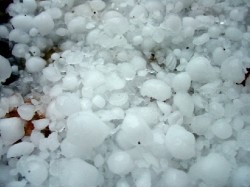Hail Damage in Ohio
 Hail is a fact of life here in Ohio, pounding our homes, our cars, and anything else that happens to be outside when the storm starts. We expect the roof on our homes to protect our families and possessions from the effects of the weather around us. They cover us 24 hours a day, 365 days a year limiting the effects of exposures to UV rays, wind, heat, rain, snow, sleet, and hail.
Hail is a fact of life here in Ohio, pounding our homes, our cars, and anything else that happens to be outside when the storm starts. We expect the roof on our homes to protect our families and possessions from the effects of the weather around us. They cover us 24 hours a day, 365 days a year limiting the effects of exposures to UV rays, wind, heat, rain, snow, sleet, and hail.
The Impact of Hail
The impact of hail on your house and other outside possession is affected by the size, density, and terminal velocity of the hail. Ranging in size from the less than ¼ inch diameter of sleet pellets to the over 5 inches diameter larger than a softball, the size of the hail cannot be the only factor when looking at the damage a hail storm can cause to a roof. The density of a hailstone is affected by the number of times the initial rain droplet rises and falls through the cold updrafts of the atmosphere creating a ball of multi-layered ice, before pelting down to beat on your roof. Tossed about in the atmosphere, the size and density of the hailstone is now under the influence of the winds generated by the storm. How hard that hail stone hits your roof and the damage it inflicts will be significantly influenced by those winds. Think of the difference you would feel being hit by an ice cube thrown by a 4 year old and being hit by that same ice cube thrown by a major league pitcher throwing it at fastball speeds!
During the Storm
Determining the possibility of hail damage starts with taking a few notes in the midst of the storm itself. Storm details that would be good to have notes about are things like the storm’s duration, the size of the hail, and the wind direction. If possible, take pictures, some general and some with a size reference – a hail stone next to a penny, ruler, golf ball, etc.
From the Ground
The effects of hail impact on your roof may not be seen from the ground, but there are a few telltale signs to look for when assessing your roof after a storm has rolled through your area. While on the ground, look for mineral granules that have washed off your roof and down your drain spout. Look at objects that were outside your home that might show hail damage – your car, plants, etc. Take a look around your neighborhood.
Up On the Roof
If you are climbing the ladder to check your roof, the first thing you will be looking for are granules that have not yet washed down your guttering. You will then look to see where those granules have come off the shingles. Areas that show granule loss will have an exposed “fresh” looking shingle substrate where that area has not yet been weathered by the sun. Larger hailstones can produce a dents or visible damage points in shingle roofs’ surfaces. Signs of hail damage can be as subtle as a small dimple in a few shingles. If you suspect damage it is best to have your roof checked by reputable roofing professionals.
At Van Martin Roofing we have the experience you need to recognize any roofing issues and will able to help you with assessing any hail damage to your roof.


